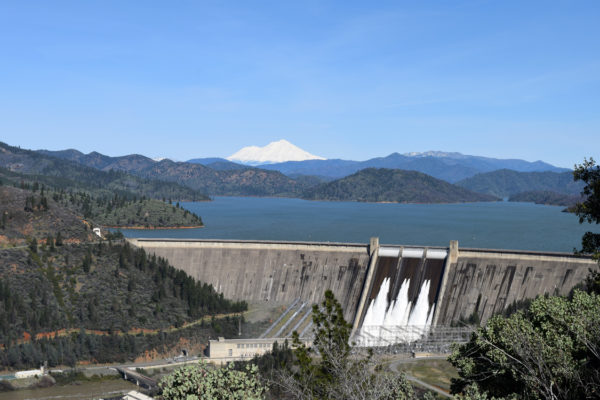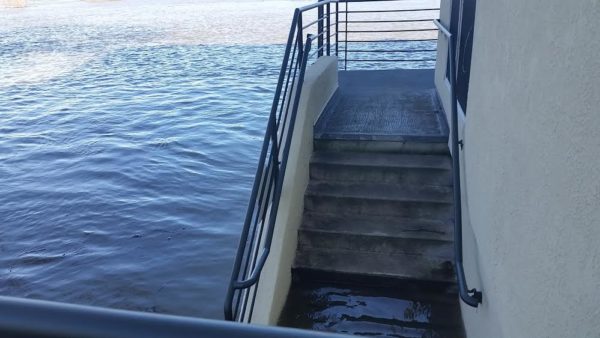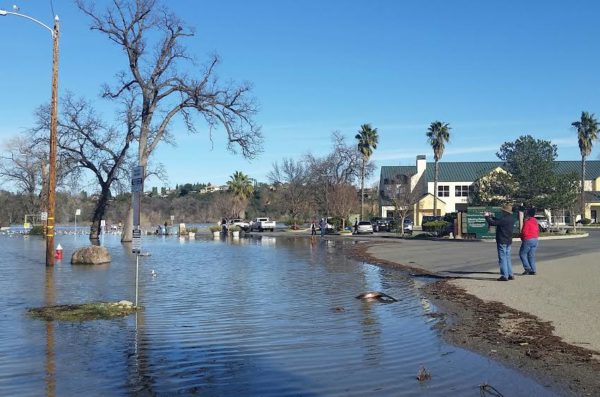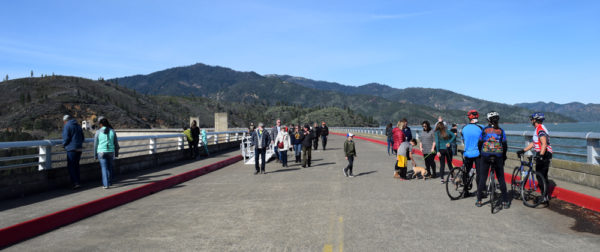
Operators opened 10 river outlets on Shasta Dam’s spillway for the first time in more than 15 years. Photos and video by Jon Lewis.
In the end, the water always finds a way to win.
Regardless of what stands in its way, it will find its way back to the ocean. And sometimes, like it has in the past few weeks, it decides to return all at once—and in a hurry.
Man-made barriers—most notably Shasta Dam—put up a good fight, but even they must yield on occasion. Last weekend was one such occasion. With Shasta Lake filled to 92 percent of its enormous capacity and six feet from its brim, and a welcome stretch of mild weather in the forecast, dam operators opened wide the spigots and loosed 70,000 CFS (cubic feet per second) into the already-swollen Sacramento River.
The high releases, which started at 50,000 CFS on Friday and ramped their way from there, promptly led to the closure of Park Marina Drive near the Cypress Bridge. The engorged river spread out over large sections of the Sacramento River Trail and generated considerable excitement among thousands of sight-seers who flocked to Shasta Dam, the Sundial Bridge and several points in between.
The central portion of Park Marina Drive just south of South Street was under water Sunday after a release of water from Shasta Dam earlier that day. Photos by Doni Chamberlain
Park Marina Drive flooded Sunday after releases from Shasta Dam that morning. Video by Doni Chamberlain.
The scene was much more serious in Oroville on Sunday as the Butte County Sheriff ordered a wide-scale evacuation of the city and neighboring communities in response to concerns that Oroville Dam’s emergency spillway would fail and send a wall of water crashing into the Feather River and cause widespread flooding.
The auxiliary spillway, located west of the massive earthen dam, was pressed into action Saturday for the first time in the dam’s 48-year history. Department of Water Resources operators cranked up releases through the principal, but heavily damaged, spillway in an effort to lower the lake level as growing evidence of erosion on the emergency spillway raised concerns.
As some 130,000 people clogged highways and streets in an effort to evacuate, DWR officials announced at 8:45 p.m. Sunday that water had stopped going over the emergency spillway. The evacuation order remains in effect until 4:15 p.m. Monday at the earliest. DWR officials have repeatedly stated that Oroville Dam itself is not in danger of failing.
For evacuation information, Butte County residents can dial 2-1-1 from landline and cell phones; Yuba or Sutter County residents can call 1-866-916-3566.
DWR contractors plan to use helicopters to drop large rocks into the damaged sections of the emergency spillway to stabilize them.
The excitement levels were especially high at Shasta Dam as people gathered to admire the rare view of water rocketing through 10 river outlets high up on the 487-foot tall spillway. Sheri Harral, a public affairs specialist for the Bureau of Reclamation, said it had been at least 15 years since dam operators had opened 10 outlets.
“We’re just getting some water out of the reservoir while we have some clear skies,” Harral said on Friday, noting the forecast calls for another storm to roll in by the middle of the week. “There will be some areas downstream that are going to get wet, but it would be a gazillion times worse if the dam wasn’t here.”
In fact, she said the flood-control releases can be viewed as evidence in support of the now-stalled proposal to raise Shasta Dam at additional 18.5 feet. “This is kind of a plug for when people say ‘why in the world are you guys pushing to raise the dam when you can’t even fill it up.”
A feasibility report released in 2015 indicates the cost to raise the height of the dam would be $1.3 billion. It would create an additional 636,000 acre-feet of storage. The project is opposed by the Winnemen Wintu people, who say it flood most of the tribe’s remaining sacred sites along the McCloud River.
Meanwhile, dam operators are scrambling to bring the lake into mandated compliance with Army Corps of Engineers guidelines on lake levels. Those guidelines are based on rainfall averages, flooding thresholds for the river and downstream communities, energy demands and agricultural needs.
“We’re 37 feet higher than we should be and almost 100,000 acre-feet encroached (or above the level required by the guidelines). We’ve gotten 71 inches of rain at the dam and our average is 62. This is all great, but when it comes all at once, that’s what can cause problems. We can only hold so much,” Harral said.
When full, Shasta Lake holds 4.5 million acre-feet of water—the equivalent of 19 Whiskeytown Lakes, or enough to fill 2.25 million Olympic-sized swimming pools—making it California’s largest reservoir and the cornerstone of the Central Valley Project. An acre-foot equals 325,851 gallons of water.
In response to the flood-control releases, Shasta County Sheriff Tom Bosenko closed the Sacramento River to recreational use and boating.
More water is on the way: the National Weather Service forecast for the north state calls for rain on Wednesday and Thursday and moderate rain and showers continuing for the next seven days.











